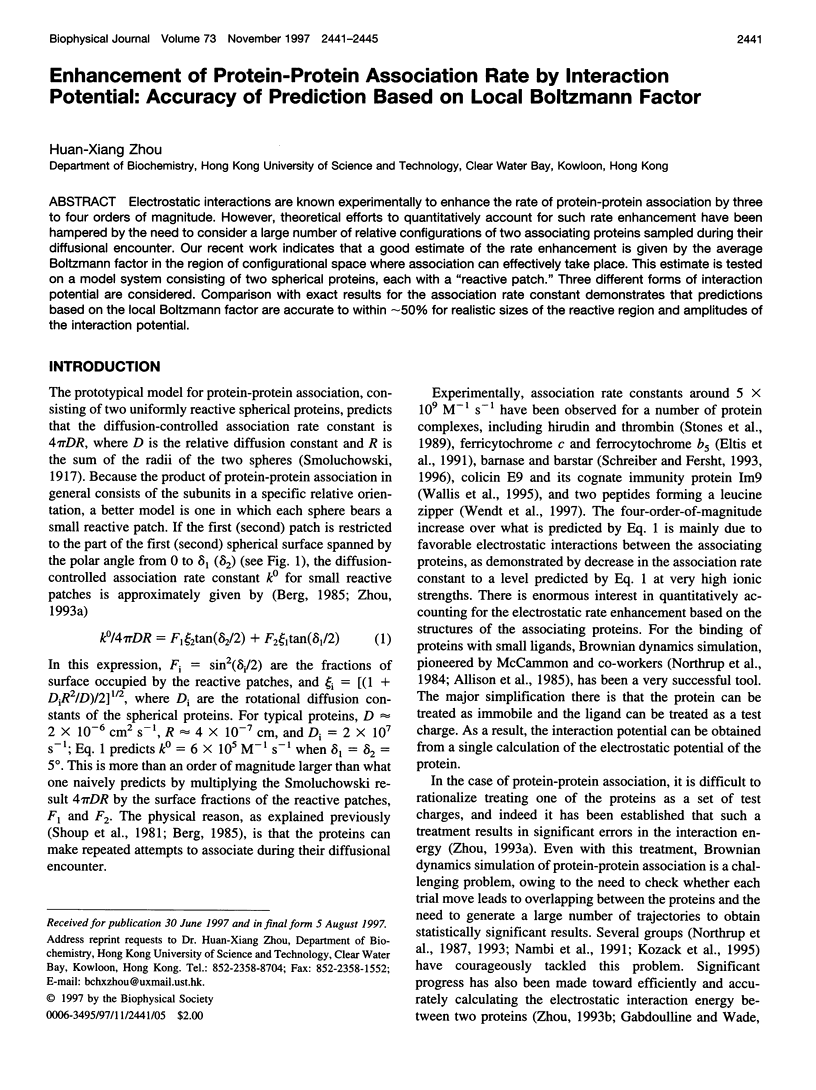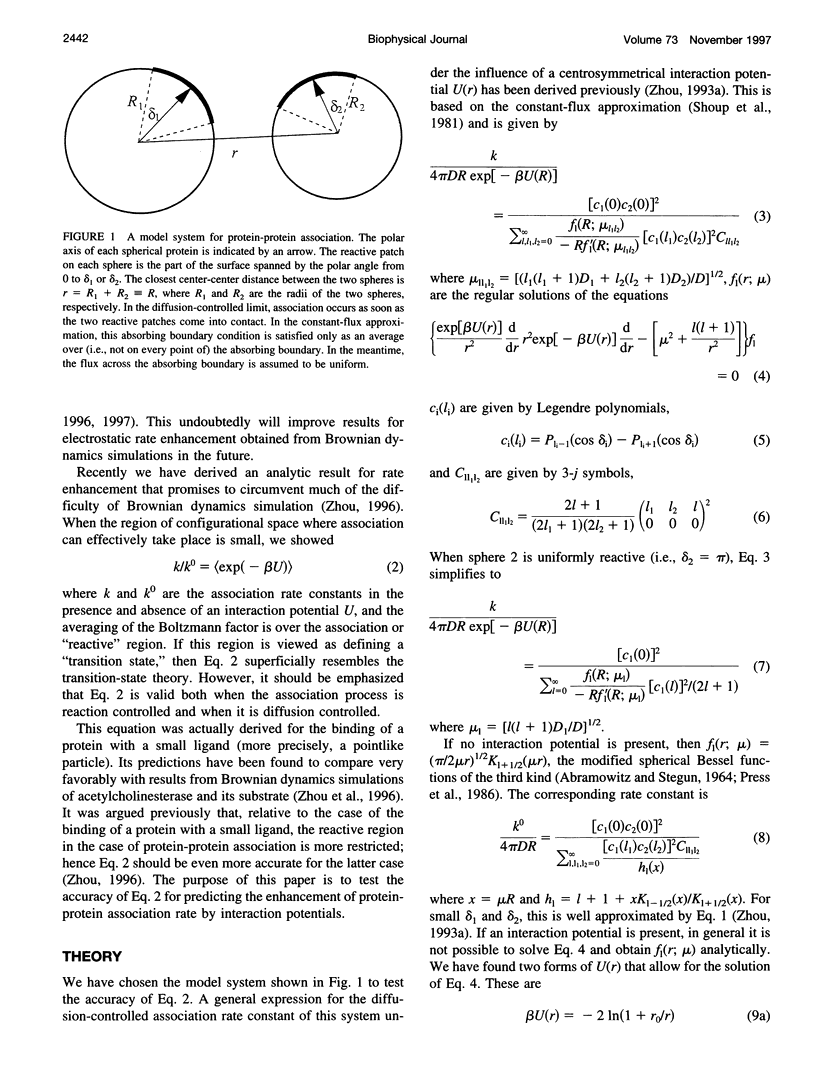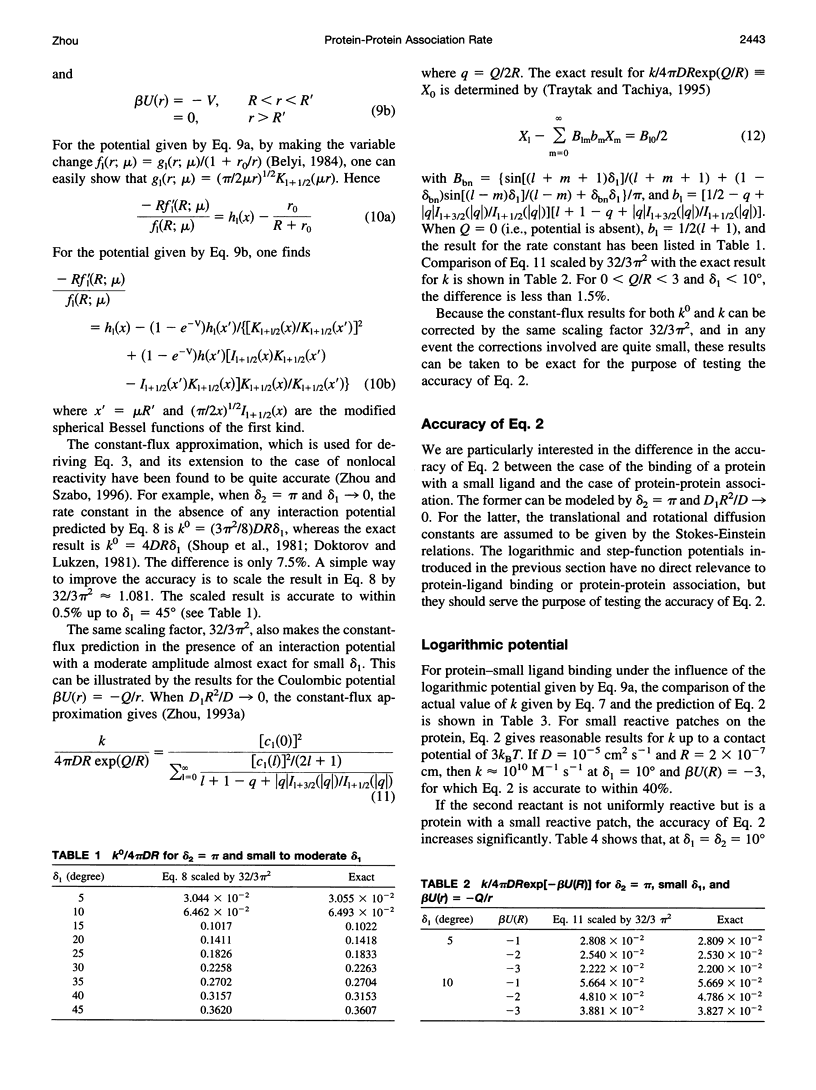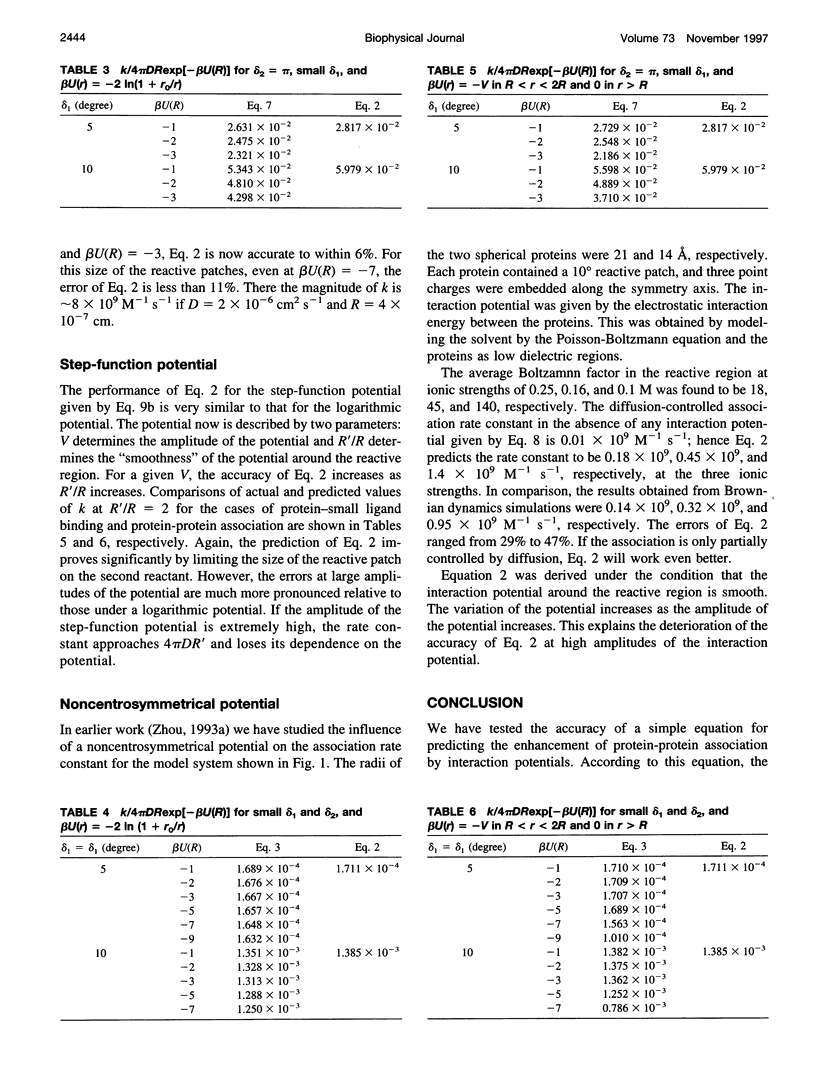Abstract
Electrostatic interactions are known experimentally to enhance the rate of protein-protein association by three to four orders of magnitude. However, theoretical efforts to quantitatively account for such rate enhancement have been hampered by the need to consider a large number of relative configurations of two associating proteins sampled during their diffusional encounter. Our recent work indicates that a good estimate of the rate enhancement is given by the average Boltzmann factor in the region of configurational space where association can effectively take place. This estimate is tested on a model system consisting of two spherical proteins, each with a "reactive patch." Three different forms of interaction potential are considered. Comparison with exact results for the association rate constant demonstrates that predictions based on the local Boltzmann factor are accurate to within approximately 50% for realistic sizes of the reactive region and amplitudes of the interaction potential.
Full text
PDF




Selected References
These references are in PubMed. This may not be the complete list of references from this article.
- Allison S. A., Ganti G., McCammon J. A. Simulation of the diffusion-controlled reaction between superoxide and superoxide dismutase. I. Simple models. Biopolymers. 1985 Jul;24(7):1323–1336. doi: 10.1002/bip.360240717. [DOI] [PubMed] [Google Scholar]
- Berg O. G. Orientation constraints in diffusion-limited macromolecular association. The role of surface diffusion as a rate-enhancing mechanism. Biophys J. 1985 Jan;47(1):1–14. doi: 10.1016/S0006-3495(85)83870-4. [DOI] [PMC free article] [PubMed] [Google Scholar]
- Eltis L. D., Herbert R. G., Barker P. D., Mauk A. G., Northrup S. H. Reduction of horse heart ferricytochrome c by bovine liver ferrocytochrome b5. Experimental and theoretical analysis. Biochemistry. 1991 Apr 16;30(15):3663–3674. doi: 10.1021/bi00229a011. [DOI] [PubMed] [Google Scholar]
- Gabdoulline R. R., Wade R. C. Simulation of the diffusional association of barnase and barstar. Biophys J. 1997 May;72(5):1917–1929. doi: 10.1016/S0006-3495(97)78838-6. [DOI] [PMC free article] [PubMed] [Google Scholar]
- Kozack R. E., d'Mello M. J., Subramaniam S. Computer modeling of electrostatic steering and orientational effects in antibody-antigen association. Biophys J. 1995 Mar;68(3):807–814. doi: 10.1016/S0006-3495(95)80257-2. [DOI] [PMC free article] [PubMed] [Google Scholar]
- Northrup S. H., Thomasson K. A., Miller C. M., Barker P. D., Eltis L. D., Guillemette J. G., Inglis S. C., Mauk A. G. Effects of charged amino acid mutations on the bimolecular kinetics of reduction of yeast iso-1-ferricytochrome c by bovine ferrocytochrome b5. Biochemistry. 1993 Jul 6;32(26):6613–6623. doi: 10.1021/bi00077a014. [DOI] [PubMed] [Google Scholar]
- Schreiber G., Fersht A. R. Interaction of barnase with its polypeptide inhibitor barstar studied by protein engineering. Biochemistry. 1993 May 18;32(19):5145–5150. doi: 10.1021/bi00070a025. [DOI] [PubMed] [Google Scholar]
- Schreiber G., Fersht A. R. Rapid, electrostatically assisted association of proteins. Nat Struct Biol. 1996 May;3(5):427–431. doi: 10.1038/nsb0596-427. [DOI] [PubMed] [Google Scholar]
- Shoup D., Lipari G., Szabo A. Diffusion-controlled bimolecular reaction rates. The effect of rotational diffusion and orientation constraints. Biophys J. 1981 Dec;36(3):697–714. doi: 10.1016/S0006-3495(81)84759-5. [DOI] [PMC free article] [PubMed] [Google Scholar]
- Stone S. R., Dennis S., Hofsteenge J. Quantitative evaluation of the contribution of ionic interactions to the formation of the thrombin-hirudin complex. Biochemistry. 1989 Aug 22;28(17):6857–6863. doi: 10.1021/bi00443a012. [DOI] [PubMed] [Google Scholar]
- Wallis R., Moore G. R., James R., Kleanthous C. Protein-protein interactions in colicin E9 DNase-immunity protein complexes. 1. Diffusion-controlled association and femtomolar binding for the cognate complex. Biochemistry. 1995 Oct 24;34(42):13743–13750. doi: 10.1021/bi00042a004. [DOI] [PubMed] [Google Scholar]
- Wendt H., Leder L., Härmä H., Jelesarov I., Baici A., Bosshard H. R. Very rapid, ionic strength-dependent association and folding of a heterodimeric leucine zipper. Biochemistry. 1997 Jan 7;36(1):204–213. doi: 10.1021/bi961672y. [DOI] [PubMed] [Google Scholar]
- Zhou H. X. Boundary element solution of macromolecular electrostatics: interaction energy between two proteins. Biophys J. 1993 Aug;65(2):955–963. doi: 10.1016/S0006-3495(93)81094-4. [DOI] [PMC free article] [PubMed] [Google Scholar]
- Zhou H. X. Brownian dynamics study of the influences of electrostatic interaction and diffusion on protein-protein association kinetics. Biophys J. 1993 Jun;64(6):1711–1726. doi: 10.1016/S0006-3495(93)81543-1. [DOI] [PMC free article] [PubMed] [Google Scholar]
- Zhou H. X., Szabo A. Theory and simulation of the time-dependent rate coefficients of diffusion-influenced reactions. Biophys J. 1996 Nov;71(5):2440–2457. doi: 10.1016/S0006-3495(96)79437-7. [DOI] [PMC free article] [PubMed] [Google Scholar]


